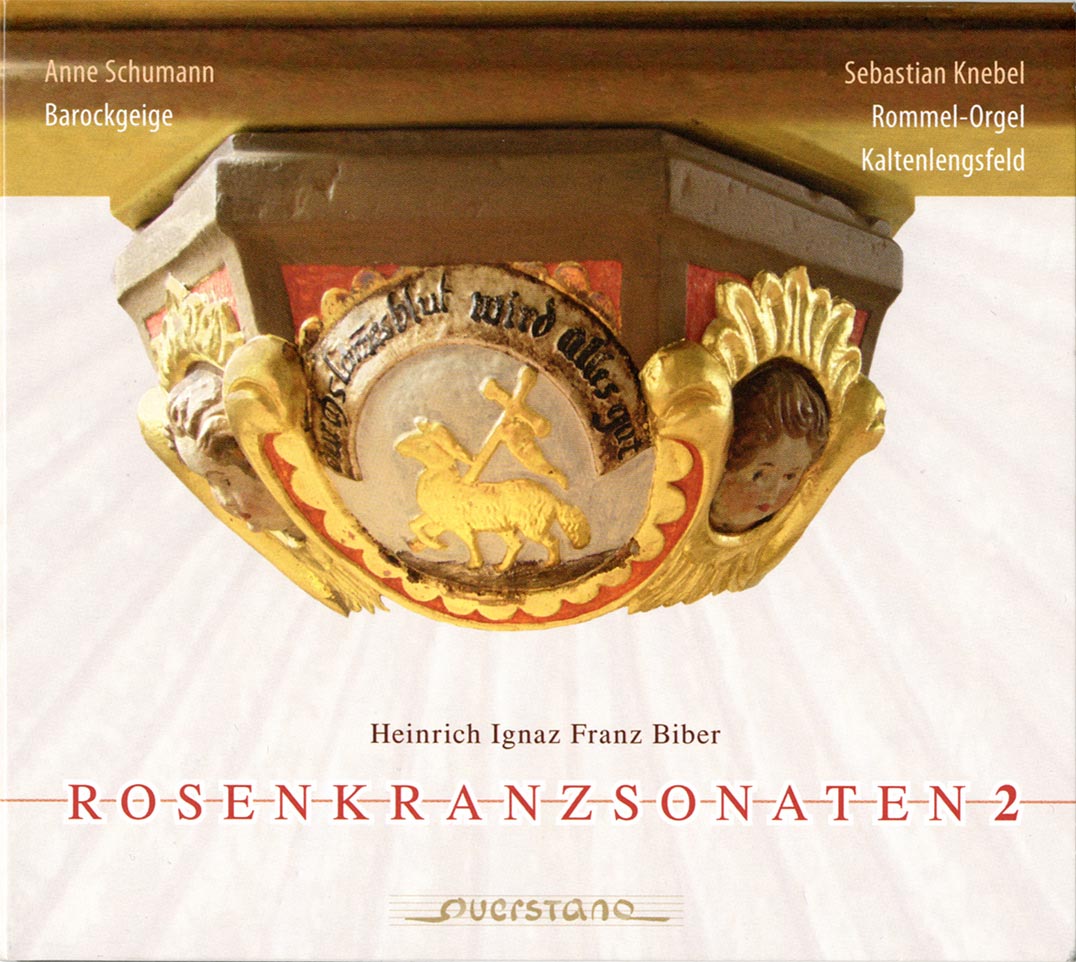[VKJK 1506]
Heinrich Ignaz Franz Biber (1644–1704) wrote his Rosary (or Mystery) Sonatas when he was working in the service of the Archbishop Max Gandolph von Kuenburg in Salzburg, to whom they are dedicated. These rich and complex pieces may now be part of a Baroque violinist’s repertoire, but they have never been recorded like this before. Anne Schumann and Sebastian Knebel play the pieces in the village church of Kaltenlengsfeld (Thüringia) and we hear the violin and the church’s organ in their full glory – the sound filling the space of the building. Schumann sees the Rosary sonatas as a collection of short stories: ‘With a violin I tell and paint the secrets of the rosary. The stories are meant to please but also stir, and encourage prayer and meditation.’ This is the second of a set of three CDs of the 15 Rosary sonatas (and the Passacaglia for solo violin), each recorded in a different Thüringian church, and each including a work for organ that shows the unique qualities of these church instruments.
The music
Bells of the Kaltenlengsfeld church
Heinrich Ignaz Franz Biber, Rosenkranz Sonata VI
Heinrich Ignaz Franz Biber, Rosenkranz Sonata VII
Heinrich Ignaz Franz Biber, Rosenkranz Sonata VIII
Heinrich Ignaz Franz Biber, Rosenkranz Sonata IX
Heinrich Ignaz Franz Biber, Rosenkranz Sonata X
Johann Pachelbel, Ciacona in D minor
The musicians
Anne Schumann violin
Sebastian Knebel organ
Anne Schumann and Sebastian Knebel are pillars of the Early Music scene in Central Germany. Anne Schumann can also be heard on the CD Musik für viola d’amore and on some of the Bach Players’ CDs that we publish.
Recording & production
Producer: Klaus-Jürgen Kamprad
Recording engineer: Falk Wiederhold
Recorded in the church of Kaltenlengsfeld (Thüringen), August 2007
Presentation
The CD is held in a digipack with a 28-page booklet of texts illustrated with photographs. Anne Schumann writes notes on the sonatas, Sebastian Knebel writes about the organs of Biber’s time and this particular organ of Kaltenlengsfeld, Matthias Schmidt writes about the church itself. All texts are given in German and English.
Reviews
These two recordings [volumes 2 and 3] conclude Anne Schumann’s exploration of Biber’s marvellous sonatas for scordatura violin in which the continuo part is realised solely on church organs of the period. The ‘direct and almost unrelenting sound’ of Kaltenlangsfeld’s Rommel organ was thought most suitable for the sorrowful mysteries on disc 2, while the glorious mysteries are accompanied on the Trost organ in Waltershausen. In both cases the recording balance favours the keyboard instrument, but not to the same extent as I experienced with the first release of the set. If Anne Schumann sounds distant in the solo Passagalia, it is because she played it in one of the loftier boxes to tie in with the composer’s dedicating it to a guardian angel. This is a performance of real strength and depth: I have never heard the rapid chains of octaves played so clearly – like bells pealing. Elsewhere there were moments of genuine discovery (as I believe there always should be when artists record repertoire that is so well know) – the martial intrada of Sonata XII with its bare harmonies and strident colours raised the hairs on the back of my neck. In the booklet note to volume 3, Anne Schumann reveals that she used three violins for the project to accommodate the testing scordatura settings (especially difficult at high pitch); when she wrote down which ones she had used for which set of sonatas, she discovered the same pattern in 12321 for the first two sets of mysteries, then a different one for the third (223311) – something for number symbolists to get excited about. Like the first volume, these two discs begin with the church bells.
Brian Clark, Early Music Review, November 2015
